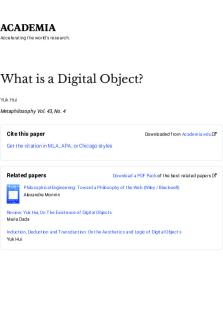The growing shift towards digital payments is strongly debated among governments PDF

| Title | The growing shift towards digital payments is strongly debated among governments |
|---|---|
| Course | Law |
| Institution | Universiti Teknologi MARA |
| Pages | 2 |
| File Size | 91.6 KB |
| File Type | |
| Total Downloads | 68 |
| Total Views | 225 |
Summary
The growing shift towards digital payments is strongly debated amonggovernments, central banks and financial experts. To justify a withdrawal ofpaper money, governments argue that a fully digitalised system woulderadicate tax evasion and money laundering, reduce transaction costs andenable financial...
Description
The growing shift towards digital payments is strongly debated among governments, central banks and financial experts. To justify a withdrawal of paper money, governments argue that a fully digitalised system would eradicate tax evasion and money laundering, reduce transaction costs and enable financial authorities to stimulate economic growth. central banks would be able to impose any desired monetary policy – including negative rates – as consumers would have no way to retrieve their cash from the banking system. My first point here is negative interest rates could be passed onto the customers and the merchants. Dropping the interest rate is typically a move to stimulate an economy, but the result is that money loses purchasing power. According to the International Monetary Fund, negative interest rates reduce bank profitability, and banks could be tempted to hike fees on customers to make up that deficit. In 2020, banks are limited in their ability to pass on those costs because customers can simply withdraw their cash from the bank if they don't like the fees. In the future, if customers can't withdraw cash from the bank, they may have to accept any additional fees. One fear of moving toward a cashless society is giving credit card companies more power — essentially a monopoly — over merchant transactions. Without fee caps in place, nothing is preventing credit card companies from raising their fees as more and more businesses rely on plastic. When all money is electronic, negative interest rates
could have a more direct effect on consumers. Countries like Denmark, Japan, and Switzerland have already experimented with negative interest rates
In a cashless world, the main problem would be the difficulty and inconsistency over payment mechanisms. If society is forced to choose from just a few payment methods, or if one app becomes the standard payment app, the companies who develop these services may not offer them for free. Payment processors may cash in on the high volumes by imposing fees, eliminating the savings that should come from less cash handling. Electronic payment apps such as PayPal, Online Banking such as GrabPay, Boost and more are not consistent. It would create a problem to custmoers to pay if there is a difficulty over payments. For example, if one customer try to pay using GrabPay, and unfortunately the merchant does not have GrabPay as their main payment mechanisms. This also applies that different merchants have their different payment mechanism and this can defineitly cause a huge problem to both the customers and the merchants. Some sectors of the economy are more likely to rely on cash payments. .For example, more than a quarter of payments to savings clubs were made in cash (26 percent), whilst 17 percent of housing rent payments were paid in cash, both up from 2015 levels. This amounts to approximately £8.7bn of rent payments made in cash in 2017. These instances again go to show that there is nothing inevitable or inherently preferable about a switch to a cashless society, particularly for sectors and businesses that are seeing consistent or even increasing levels of cash payments, or for the people who choose to spend their own money using cash. Thus, merchants only accept only a specific type of cashless method. If consumer is using different method, the capability to conduct transact might be effected....
Similar Free PDFs

The Second Shift summary
- 3 Pages

Sweeney Among the Nightingales
- 1 Pages

Redundancy payments
- 6 Pages

Body Ritual Among the Nacirema
- 5 Pages

Among the Hidden Chapter Summary
- 3 Pages

Shift Kerja
- 1 Pages

Hidden Rules Among the Classes
- 6 Pages

What is a Digital Object?
- 17 Pages

Growing up native
- 3 Pages

Growing child notes
- 122 Pages
Popular Institutions
- Tinajero National High School - Annex
- Politeknik Caltex Riau
- Yokohama City University
- SGT University
- University of Al-Qadisiyah
- Divine Word College of Vigan
- Techniek College Rotterdam
- Universidade de Santiago
- Universiti Teknologi MARA Cawangan Johor Kampus Pasir Gudang
- Poltekkes Kemenkes Yogyakarta
- Baguio City National High School
- Colegio san marcos
- preparatoria uno
- Centro de Bachillerato Tecnológico Industrial y de Servicios No. 107
- Dalian Maritime University
- Quang Trung Secondary School
- Colegio Tecnológico en Informática
- Corporación Regional de Educación Superior
- Grupo CEDVA
- Dar Al Uloom University
- Centro de Estudios Preuniversitarios de la Universidad Nacional de Ingeniería
- 上智大学
- Aakash International School, Nuna Majara
- San Felipe Neri Catholic School
- Kang Chiao International School - New Taipei City
- Misamis Occidental National High School
- Institución Educativa Escuela Normal Juan Ladrilleros
- Kolehiyo ng Pantukan
- Batanes State College
- Instituto Continental
- Sekolah Menengah Kejuruan Kesehatan Kaltara (Tarakan)
- Colegio de La Inmaculada Concepcion - Cebu





